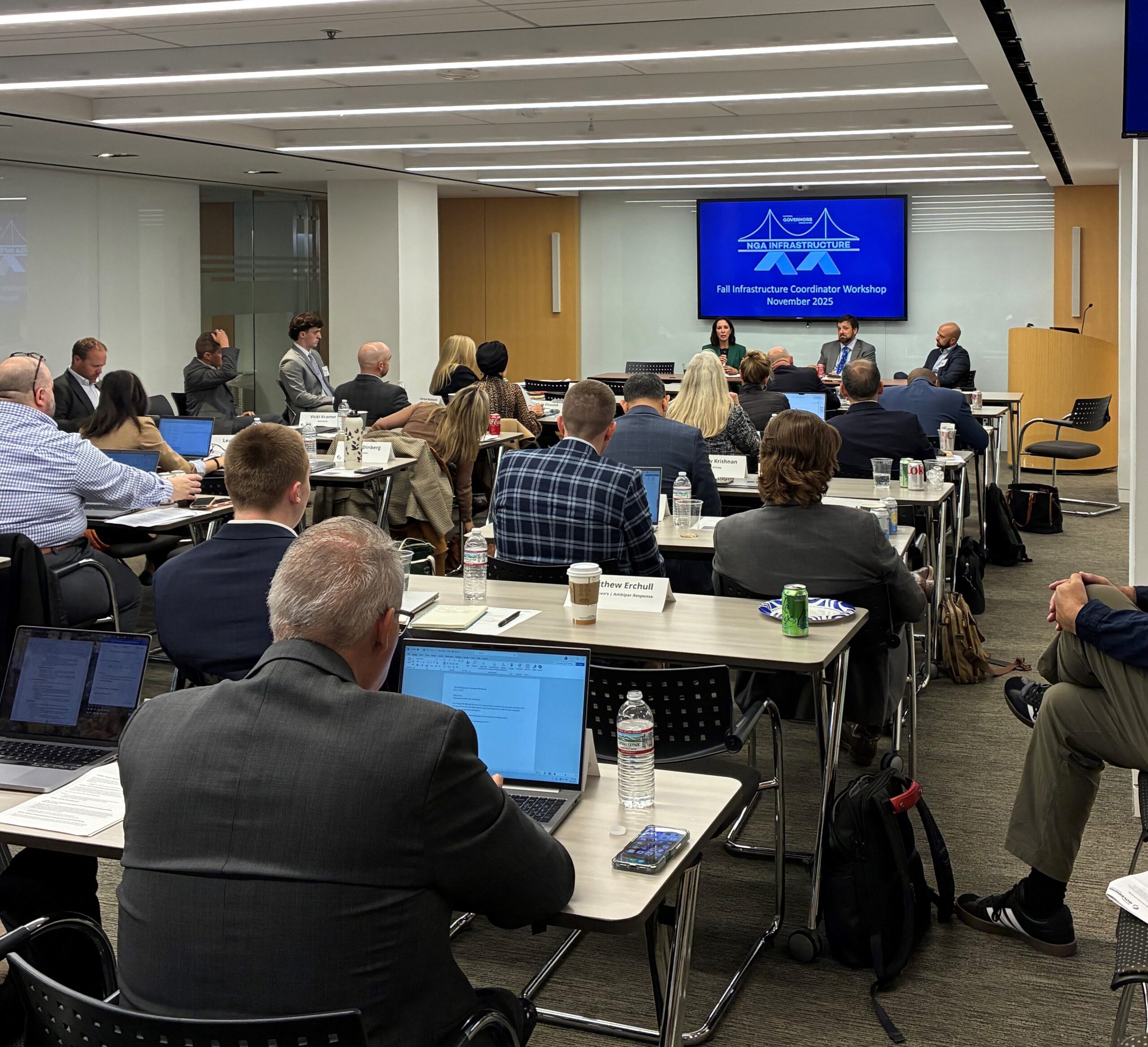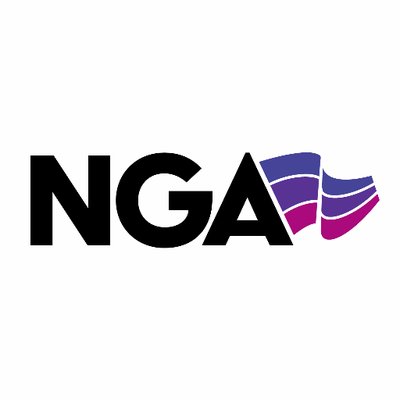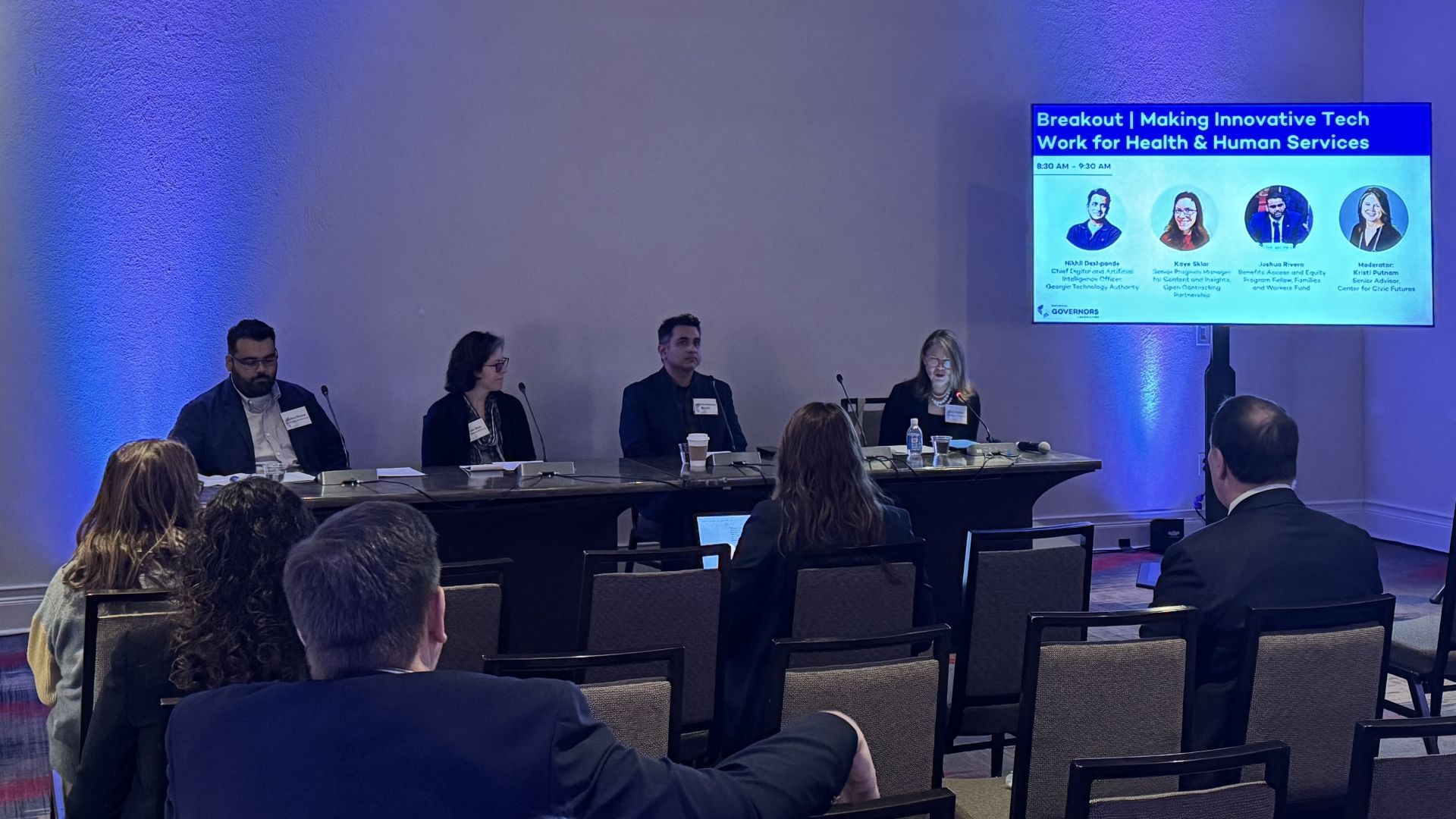As states and territories across the country work to address the challenges that many youth face related to their mental health and wellbeing, Governors can engage youth themselves to drive meaningful policy change in their states. Perspectives from youth regarding on-the-ground program gaps, in-school experiences, and program and service delivery preferences can help states make practical improvements that make their programs and policies more effective. Meanwhile, direct engagement with youth allows Governors to tap into a new and excited constituency, youth and young adults, who are actively seeking to affect change and improvements to the systems around them.
This report serves as a practical roadmap for leaders, providing actionable best practices for incorporating youth voice into policymaking, particularly related to youth mental health. Compiled from lessons learned across the 2024 National Governors Association (NGA) Policy Academy to Drive Thriving Youth Mental Health, where states embedded youth advisors directly into their project teams, this report outlines strategic frameworks and recommendations for recruitment, operational best practices and compensation considerations – all designed to help Governors and their teams build sustainable, meaningful partnerships with youth to inform better mental health policies that improve state and territory outcomes.
(Download)
Background
The 2024 NGA Policy Academy to Drive Thriving Youth Mental Health (Youth Mental Health Policy Academy) kicked off in March 2024, following the completion of the 2023-2024 NGA Chair’s Initiative led by former NGA Chair New Jersey Governor Phil Murphy on Strengthening Youth Mental Health. Over the course of the year, NGA supported six states (Alabama, Hawai‘i, Kentucky, Oklahoma, Virginia and New Jersey) working to implement the best practices detailed in the NGA publication “Governor’s Playbook on Strengthening Youth Mental Health” released as part of the Chair’s Initiative, which included policy solutions to address the unique needs of their diverse youth mental health systems.
While this policy academy focused on supporting Governors’ offices in tackling issues for youth, a critical factor of the project was to support Governors in tackling these issues with youth. As part of his NGA Chair’s Initiative, Governor Murphy prioritized the inclusion of youth voice in all aspects of the Initiative’s work, ensuring that youth actively participated in each of the Initiative’s events – seated at the same table as Governors at each roundtable – and including their voices and perspectives in the development of a Governor’s Playbook publication. As part of Governor Murphy’s initiative, several roundtable discussions were held across the country. Each roundtable featured discussion specifically aimed at youth and featured youth as equal participants in the policy conversations, which set the tone about the significance of their contributions. The 2024 Youth Mental Health Policy Academy continued this priority by embedding youth advisors directly into the state teams to contribute their own lived expertise and ideas into each state’s project implementation.
This report provides state and territory leaders with actionable best practices for how to incorporate youth voice successfully into their policymaking conversations, especially in youth mental health. These recommendations are sourced from the NGA youth advisors and state team leaders and provide tactical and practical advice for any state or territory to employ. Quotes in this report were provided by NGA youth advisors, but names are not included to protect their privacy and maintain the confidentiality of the participants.
Methodology
For the 2024 Youth Mental Health Policy Academy, NGA required that participating state teams include at least one Youth Advisor to walk alongside team members in their efforts. To facilitate this objective, NGA supported the compensation and expenses of one youth advisor for each of the teams. Project teams selected their own youth advisor, who participated in state team planning as well as NGA-facilitated convenings (monthly technical assistance check-ins, bimonthly peer state learning calls and in-person site visits). Youth advisors also engaged with their peer-youth advisors from other states through an NGA-hosted Youth Advisory Council (YAC).
To accommodate peer learning and cultivate a safe space for the youth advisors participating in this project, NGA stood up the Youth Advisory Council to mirror the peer learning spaces available to the larger state team cohort. The Youth Advisory Council included each policy academy states’ Youth Advisor and entailed quarterly meetings of the council to facilitate peer-sharing and knowledge-building. Focusing Youth Advisory Council meetings on emerging policy topics in youth mental health allowed NGA to not only support youth advisors in building their own expertise in the policy space but also afforded NGA access to direct insights and feedback into the youths’ experience working directly with the state teams.
Topics and speakers included:
- Effective Storytelling, featuring Young Invincibles – Leaning on youth advisors’ backgrounds and/or interest in advocacy, this call centered around strategies to craft persuasive messaging and communications to influence change.
- Introduction to Youth Mental Health Policy, featuring the Bipartisan Policy Center – Delving into the difference between the role of federal and state and territory government in policy-making, the Youth Advisory Council explored key federal funding streams and regulatory statutes that shape the youth mental health policy landscape.
- Career and Personal Development, featuring the Pennsylvania Commission on Next Generation Engagement – To support youths’ experience with the Youth Advisory Council as an investment that leverages their lived expertise and growth, youth advisors learned about networking and professional development strategies to accelerate a career in policy.
The Youth Advisory Council was supported by the expertise of Young Invincibles, an organization working to amplify the voices of young adults in the political process and expand economic opportunity for the new generation. Throughout the course of the Policy Academy, Young Invincibles provided recommendations about best practices to both NGA and Policy Academy cohort states. The Youth Advisory Council and participation of youth advisors in the Policy Academy constituted one of the first formal efforts to embed youth voice into NGA’s delivery of long-term technical assistance, and YI’s support and expertise was critical to developing the framework for engagement.
NGA’s 2024 Youth Mental Health Policy Academy
The 2024 NGA Youth Mental Health Policy Academy was a continuation of the work first brought to life by the 2022-2023 Chair’s Initiative on Strengthening Youth Mental Health, led by former NGA Chair New Jersey Governor Phil Murphy. NGA’s policy academy project model affords Governors the opportunity to convene a multidisciplinary cross-agency team to receive in-depth technical assistance and facilitation support to execute a state-determined proposed scope of work and engage in multiple virtual and in-person peer learning opportunities. The six state teams participating in the policy academy met monthly with NGA facilitators, as well as bimonthly with the entire cohort, pairing state teams with peer states, experts and organizations supporting youth mental health policy improvements. Teams also attended two in-person meetings: a kickoff event in Charleston, South Carolina, and a state and territory symposium on youth mental health in Fort Myers, Florida.

More information about the process and outcomes from the Policy Academy can be found in the forthcoming final report.
State staff recommendations are indicated with a purple star.
This report, and successes resulting from the 2024 YMH Policy Academy, would not have been possible without the expertise of our youth advisors: Oliver, Spandana, Reagan, Tianna, Tiffany, Jack, Ekansha, and Braylea. We are so thankful for the experience to work with and learn from you. We’re also grateful to the state participants and team leads who dedicated their time to drive progress in youth mental health and demonstrated leadership and innovation over the course of the project.
Section 1: Framework for Engagement – A View Across States and Territories
State and territory leaders have many different models* for youth engagement at their disposal, depending on needs, goals, and staff capacity. States vary in how they engage youth, and leaders can exercise creativity in design, scope and leadership of the structure. Some of the considerations for youth engagement models include:
Councils or Consultants
- Youth councils are typically comprised of more than five youth and are charged with consolidating and aligning feedback from a diverse set of perspectives.
- Youth consultancy programs typically involve one or two youth providing more intensive feedback on a specific issue or project.
- Youth councils help states collect feedback from a multitude of perspectives, while youth consultants can provide in-depth insights and be involved from program ideation to implementation.
Scope
- Some youth councils have a predetermined specific charter that defines the focus and outcomes of feedback supplied by youth. Such scope may be broader (e.g., “youth mental health”) or narrower (e.g., “school-based youth mental health services”) depending on the construct.
- Additionally, states maintain youth councils that operate without predetermined policy goals and instead allow the youth advisors to provide feedback on an array of issues such as climate change, workforce and education.
Governor or Agency-led
- Most states and territories have some type of youth engagement structure already, such as a child-welfare focus group within the family-serving agency. By having agencies lead youth engagement, states drill down into agency-specific policies or populations and capitalize on existing relationships youth may have with agency staff.
- Some states have the Governor’s Office lead youth engagement directly, which can provide a clearer line of sight to top “decision-makers” in the state.
Select State Examples
- Mississippi: The Mississippi State Superintendent Student Advisory Council lives within the Department of Education and includes students in grades 11-12. The goal of the Committee is to build a bridge between the Department of Education and public-school students.
- New Jersey: The Office of Family Voice within the NJ Department of Children and Families operates a Youth Council, which was created in 2020 and is comprised of 24 youth ages 14-23. The council has several goals, including developing recommendations for the Department of Children and Families (DCF) and educating parents, judges and community members about issues of importance to youth involved with DCF.
- Pennsylvania: In June 2023, Pennsylvania Governor Josh Shapiro created the Commission on Next Generation Engagement through E.O. 2023-14. The Commission is comprised of 30 constituents between the ages 16-26 and advises the Governor on a broad swath of issues, including mental health, voter engagement and education.
*For more information on the landscape of youth councils, see Appendix.
Section 2: Building Engagement Structures – Strategic Recruitment
By taking a deliberate approach to recruitment, state and territory leaders can ensure they have compiled myriad youth perspectives from different walks of life. This variety in perspectives contributes to a stronger system that can pressure-check policy solutions.
NGA youth advisors provided the following recommendations about getting youth involved in these programs, and they emphasized the importance of recruiting advisors outside of the “A+ student, class president” mold, especially when seeking insight on youth mental health policy.
Leverage existing state, territory and community networks to cast a wide net
NGA advisors said many of them were originally connected to the NGA project through another organization they were involved in, such as a student roundtable, community-based organization or an agency council. Organizations closer to the ground, like child welfare agencies or community providers, likely already have established relationships with youth with lived expertise and make for helpful recruitment scouts. One of the most efficient ways for executive leaders to enlist youth with lived expertise is to assess which facets of the government are already working with youth and then charge those teams with recruiting participants.
Meet youth where they are, both in-person and online
Disseminating communications and awareness materials into the spaces where young people are present, both physically and digitally, is an effective recruitment strategy. NGA advisors reinforced the belief that the majority of youth have an online presence on applications like Instagram or TikTok, and that they’re more likely to see messaging about these opportunities on social media than anywhere else. States and territories can leverage existing social media channels to push out information about opportunities for young people.
Interestingly, physical spaces are still just as relevant, and youth advisors reported that recruiting youth in the physical places they inhabit, namely schools, libraries and community centers, continues to be advantageous. Government actors should be encouraged to look to schools or other outlets which may host student clubs or youth organizations focused on mental health and well-being, which can distribute promotional materials about opportunities to serve on councils.
Break the mold of the “ideal candidate”
One of the most common pitfalls is the “intern trap,” where access to opportunities, like advisory or council positions, are offered first or exclusively to young people who are already “in the room,” like interns who are already placed within government positions/offices. Young people who are already involved in government tend to be ambitious and motivated, which can be a helpful trait for policy-making conversations, but state and territory leaders should reflect on their goals for youth engagement and aim to recruit youth most impacted by government programs and services, which may not be the same youth who have already secured highly competitive internships.
Advertise additional participation benefits and professional development
Engagement opportunities can provide a valuable chance for youth to develop personal and professional skills. By framing youth advisory roles as skill-building opportunities, states and territories can create mutually beneficial arrangements that both improve policies and prepare young people for future careers in public service or advocacy. State and territory leaders can foster these skills and formalize trainings or resources that cultivate advisors’ expertise, such as resume workshops, networking events with state and territory leaders, public speaking training, and policy education.
NGA advisors shared that state and territory staff can help young people add volunteer or advisory work on their resumes, noting young people may need assistance in translating their participation and role into a portfolio, CV, resume, or college or job application. NGA advisors also reflected on how individual state or territory staff can offer access to their personal networks, like facilitating connections to national organizations, sharing internship opportunities or writing recommendation letters as a value-add for youth.
Section 3: Operations—Fostering and Maintaining Meaningful Engagement
“It can be frustrating for youth to feel like their suggestions are not taken seriously. Youth may not know whether or not their suggestions are politically or administratively feasible.”
Cultivate Trust
Trust is a foundational element for developing any kind of partnership, especially when establishing a relationship between youth and staff, and is key to cultivating genuine perspectives and feedback. Taking deliberate efforts to foster an environment that upholds a culture of trust encourages honesty and transparency for feedback and problem-solving that are essential to a comprehensive policy-development process.
Invest in building strong relationships between staff and youth advisors
The quality of relationships between council or commission members can determine young people’s willingness to provide honest feedback. States can foster these connections through team-building activities, informal check-ins, and conversations beyond immediate policy tasks. NGA advisors highlighted relationship quality as a key factor in their authentic participation and appreciated adults who made a genuine effort to connect, like asking about their days or interests outside of youth mental health. These relationships help youth advisors feel like they’re valued as partners, rather than subordinates.
Provide clear and honest expectations about role, commitment, timeline, scope of feedback and project context
A common pitfall of youth engagement is related to managing expectations and over-promising outcomes; by nature of their age, youth advisors may have had limited working experience, and government bureaucracy can feel especially confusing or slow to a lay audience. State and territory leaders are encouraged to be proactive in their development and communication of clear guidance about the parameters of youth consultant roles and structures, such as clarity around time commitment, project context, expected outcomes, and how insights, perspectives and feedback offered by youth will ultimately be used. State and territory advisors should provide a concrete vision of what the youth’s feedback will produce while also delineating clear context about 1) why the state or territory is looking for feedback, 2) what kind of feedback the state or territory is seeking, and 3) what youth are expected to bring to the table.
Staff can further mitigate disappointment or misaligned expectations by explaining the decision-making process and sharing upfront insights into potential hurdles, both political and procedural, that the project may encounter.
Anticipate potential tension on policy issues/strategies

Youth advisors lamented previous experiences where feedback and solutions they offered to address system failures was met with an immediate “no,” or where adults were quick to present explanations about the impossibility of change rather than explore solutions; such dismissals can easily yield frustration and disillusionment. While state and territory leaders may be well aware of the gaps, realities and shortcomings of operating statewide systems, youth advisors may not fully understand the existing barriers, like funding, regulations, or political will, that can hamper progress. States can mitigate this tension by upholding and maintaining a culture of respect at group meetings, and model comportment that prioritizes curiosity and openness to problem-solving over criticism and defensiveness to undertake open and honest communication channels with youth advisors about what is and is not possible.
“Youth councils are going to ‘say it how it is’ based their experience, and it’s a different perspective that you can’t get from professional experience. You may have youth that have been involved with different parts of a system longer than certain policymakers have been in office.”
Assign dedicated staff that have a balance of leadership and capacity

Finding a staff member who has the capacity, bandwidth and jurisdiction to lead can be a critical key to success. Both youth advisors and state and territory leaders endorsed the best practice of maintaining consistent, dedicated staff on the project team to work with youth advisors. Trusted “adult allies” that youth could connect with and count on to be present was important to building confidence and buy-in from all participants. Furthermore, employing creative strategies to establish a line of sight for youth to decision-makers, like hosting an annual meeting between youth advisors and the Governor (or a Governor’s designee) or establishing expectations that leadership attend a pre-determined number of meetings helps maintain commitment to the project.
Mitigate Tokenism
“It’s critical to have meaningful student voice rather than superficial student voice – it can ‘look good’ to have a board or have a council but there needs to be accountability at the end of the year.”
A common critique of community engagement entails feedback mechanisms perpetuating “tokensim,” which has been described as the illusion of “inclusion and participation in decision-making processes without giving people real influence or power.” NGA youth advisors, reflecting on prior experiences, described the feeling that leaders wanted to create the superficial perception of including youth “lived experience” voice for a political win. Tokenization can be created through a series of small, unintentional or consecutive decisions by leaders, and states and territories looking to develop effective youth engagement structures should consider the following lessons learned:
Ensure youth councils, or components of the council, are led by youth whenever possible
Youth advisors reported that the presence of peer leadership made their youth peers more comfortable sharing honest opinions and helped boost perceptions of youth as genuine partners in identifying solutions. Moreover, helping youth develop leadership skills through training and mentorship can foster more dynamic engagement among youth advisors while also cultivating a young person’s capacity to lead, such as by affording youth the opportunity to chair meetings, set agendas, or lead specific workstreams. Across the board, testimony from NGA youth advisors affirmed that youth are hungry for opportunities to flex their leadership skills in service to these initiatives.
Heed unintentional tokenization
State and territory leaders or other adults can unintentionally create situations that demean or disrespect young people’s participation, such as alienating youth or inviting them into conversation only on superficial or inconsequential matters.
Many of the NGA youth advisors shared, upon reflecting about their own previous experiences and those of their peers, that one of the most pervasive negative feelings associated with government engagement efforts is that decisions are “made by the adults” after the youth have left the room, which can leave youth feeling, as one advisor reported, excluded and patronized. NGA youth advisors reflected that while it often does not represent a deliberate act of malice, the action still unintentionally sidelines youth voice. Transparency about which meetings youth will and will not attend, providing context about decisions made elsewhere and creating appropriate opportunities for input before decisions are finalized can help reduce the perception that youth are removed from the room before the real work can start.
“Tokenization is difficult to avoid if you’re not thinking about it – state leaders need to rewire their thinking, asking questions like: ‘Am I checking on the youth? Are people passively or actively including the youth?’”
Invite youth directly into the conversation
In scenarios where there are more adults than youth participating in conversations, power dynamics can prove difficult to maneuver, contributing to intimidation or other barriers that make it difficult for youth to share thoughts, opinions and feedback. NGA youth advisors reported their appreciation for actions that their Policy Academy team leads would make to explicitly invite them into the conversation: Efforts like deliberately and directly asking in group meetings for youths to contribute were particularly noted and served to model continued expectations for other group members. High-profile or leadership staff following this best practice will establish and reinforce expectations that leadership seeks and values hearing directly from youth.
Prioritize youths’ expertise, not their trauma
Taking a deliberate and sensitive approach to how and when young people are asked to tell their story can help promote a culture of meaningful contributions. Certainly, real stories of youths’ experience help to humanize the issues that government is addressing and contextualize the actual policy issues at hand. Many of the NGA youth advisors reflected on the strategic impact their stories can have on policy decisions; however, they also reported that it’s not uncommon for their stories to be deployed by government actors for shock value, which can exacerbate the perception that a youth’s only asset and/or contribution is their trauma. Asking youth to relitigate or relive what are often traumatic experiences, while at the same time withholding opportunities to partake in solutions-oriented conversations, erodes their trust in public systems. To avoid this, government leaders should be judicious in their efforts to ensure youth that share their lived experience perspectives also have a role in shaping reform efforts, including by contributing opinions on systems and services whenever possible. Leaders can take care to work with young people to affirm their comfortability and emotional safety and to establish trust between the two parties.
Balance Practicality with Reality
NGA youth advisors shared a number of practical implementation suggestions for state and territories.
Be creative with one-off or low-lift models of engagement
Time-limited options like roundtables, focus groups, surveys, or digital campaigns can reach youth who cannot commit to regular participation. Broader discussions, like student-focused roundtables, can involve youth who may be hesitant to discuss intimate issues, like mental health. When reflecting on their personal trajectories, NGA advisors shared how they initially got involved in government: joining a lived experience focus group, attending a student roundtable, or joining a club at school. These stories represent the diverse ways that states and territories can engage youth beyond formal councils or commissions.
Provide resources and trainings to help youth understand policy, terminology, and systems
The “alphabet soup” of acronyms for funding streams, programs, regulations, or organizations can be challenging for even the most informed policy wonk to decode. The language of policy may present a barrier to entry for youth advisors when they are exploring policy for the first time. Helping youth advisors understand the basics of things like federal funding, state/territory and federal jurisdictions, key regulation and “hot topics” can be accomplished by providing terminology glossaries, policy summaries, or explanations of government structures to ease policy language barriers.
“Youth advisors face gaps in understanding certain policies – it can be hard getting up to speed, and they can feel lost if they don’t understand what’s going on. States should take efforts get the youth up to speed on critical policies and terminology”
Be flexible when scheduling around school, and help youth balance other commitments
Youth face unique scheduling constraints due to school, extracurricular activities, jobs and family responsibilities. States can increase participation by scheduling meetings outside of school hours, providing sufficient advanced notice, or offering hybrid or recorded sessions for later viewing. Should youth be unable to attend a few meetings, state and territory staff should develop an attendance structure that allows for an occasional absence while adhering to the core expectations of the project. Successful practices include surveying youth about availability, frontloading key discussions and creating multiple participation pathways with varying time commitments.
Center patience and understanding

When youth advisors are asked to give their own testimony or provide feedback based on their own experiences, they may have to navigate how their past trauma or experiences affects their ability to engage in policy projects. Effective youth engagement requires patience and a recognition that youth are developing professional skills while navigating complex issues that can be emotionally taxing. Youth may need more time to process information or establish a sense of safety in formal settings, which might be particularly sensitive or challenging when exploring issues related to child welfare, mental health, or juvenile justice systems. A supportive, collaborative and kind environment can yield a safer space for brainstorming on policy outcomes.
Employ more than one youth advisor, even if following a consultancy model

Both state and territory leaders and youth advisors participating in the NGA Policy Academy recommended teams have more than one youth advisor. Employing at least two youth advisors can make them feel more comfortable sharing their insight and thoughts in a conversation. NGA youth advisors shared that they relied on their peers for moral and intellectual support, and this arrangement alleviated the pressure to speak for an entire generation. Like full-time staff, youth advisors may need to unexpectedly withdraw from participating for reasons like family emergencies or school obligations and employing more than one advisor can be critical for continuity.
Partner with an intermediary organization to manage administrative and logistical responsibilities

Partnering with intermediary organizations can provide an effective alternative pathway when state and territory systems make it difficult to develop a youth council or compensate youth involved. Community-based organizations, foundations or universities often have more flexible administrative processes and established relationships with youth populations, with the added benefit of also having valuable expertise in youth engagement. These partnerships can help states navigate logistical challenges related to youth compensation, transportation coordination, and administrative processes. For example, some states in the NGA Policy Academy leveraged relationships with local youth-serving nonprofits to manage stipends and transportation reimbursements. By building these partnerships, states can maintain their leadership role in the policy development process while benefiting from the administrative flexibility and youth engagement expertise of partner organizations.
Section 4: Compensation – Providing Value in Exchange for Insight
Before launching youth engagement initiatives, state and territory leaders should meet with their human resources and procurement staff to thoroughly assess the administrative implications of various ways of compensating youth. Compensation can pose budget and capacity complications and create issues related to taxes, family and individual benefit eligibility and payment processing can present hidden complexities.
Participation in a youth council or government youth advisory role may entail a youth’s first, or early, professional experience, and they may be unfamiliar with processes or concepts career professionals take for granted, under an assumption of common knowledge. Offering assistance in submitting reimbursement and expense reports, as well as guidance and tutorials regarding invoicing, reimbursements, and disbursements, may be required depending on the age and life experiences of youth participants.
Reflect on organizational structure/administrative rules
Guiding questions to consider around compensation structures for youth engagement:
- What payment or compensation mechanisms are available in my state/territory and what are the associated human resources implications of such mechanisms?
- E.g., can youth advisors be paid via honorarium? What compensation methods (checks, gift cards, tuition support) are available and which are prohibited?
- How may compensation impact the target demographic?
- How will the state or territory support youth in understanding their compensation obligations?
- What are the tax implications for the state or territory and for the recipient?
- Are there any community or national organizations available to partner that can more easily navigate providing compensation?
Pay youth advisors via check, if possible
Across all youth advisors engaged in the Policy Academy, payment by check was far and away the preferred form of compensation. As opposed to gift cards or tuition support, advisors reported appreciation for the ability to apply their compensation in the way that matched their own individual needs, whether that was covering school and tuition costs, or basic needs such as rent and groceries.
Explore alternative compensation options, like gift cards, tuition support, or technology
Gift cards, tuition support, technology stipends or professional development opportunities can all serve as meaningful alternative forms of compensation when direct payment may complicate a youth’s eligibility for benefits or be a challenge given a state’s financial regulations. Additionally, states may offer educational stipends that contribute to college savings accounts or provide physical technology that supports youth advisors’ academic or professional pursuits. For example, the Maryland Youth Advisory Council under the Governor’s Office for Children offers service learning hours for council members.
These alternatives not only recognize youth contributions but may also help overcome some administrative hurdles that arise with traditional employment arrangements.
Provide transportation support/mileage reimbursement
Youth advisors identified transportation limitations as a primary reason peers declined participation opportunities. It can be especially difficult for youth in suburban or rural areas of the state or territory to travel into urban settings, where most government offices are located. State and territory leaders can mitigate this barrier by providing transportation support through mileage reimbursement, rideshare credits, public transit passes or coordinated carpooling.
Conclusion
“These youth are going to go on to be people that share their story forever and fill in jobs in the state. The current system will turn over, and we will have people being guided by their lived experience – these youth are the future. They’re going to be our next generation of social workers, therapists, doctors, lawyers, community leaders, and Governors. It’s important to hear their perspective now.”
Meaningful youth engagement is not merely a checkbox for state and territory governments but a strategic imperative that enhances how policies are developed and implemented. When youth are treated as valued partners and architects rather than passive recipients of policy, the resulting initiatives and efforts are more likely to be responsive and better received by the populations that use them. Moreover, youth engagement is an investment in both the present and the future – affording youth advisors the opportunity to influence and improve the systems that exist to support their needs, as well as empowering them to continue to engage and develop their civic systems tomorrow. When enacted purposefully, effective youth engagement can inspire meaningful improvements and enhanced outcomes by leveraging lived experience and expertise and also strengthen the connection between government and the populations it serves.
Through these frameworks, Governors can leverage these best practices to inform their engagement efforts and ground their policy in the real, lived experience of the experts they seek to aid – the youth themselves. As Governors seek to foster solutions to the challenges faced by their constituents, the National Governors Association stands ready to aid state and territory leaders in continued efforts to embed and engage youth as valued partners in policymaking.
Appendix
Please download the PDF version of this report for a spreadsheet, compiled by NGA as part of the 2024 Policy Academy, which catalogues criteria and parameters across state- and territory-level youth councils active as of June 2024.
Acknowledgements
This paper was developed by:
- Jessica Kirchner, Senior Policy Analyst – Children & Families, National Governors Association Center for Best Practices
- Jordan Hynes, Children & Families Program Director, National Governors Association Center for Best Practices
- Brianna Keys, Consultant
This report was made possible by support from Pivotal Ventures, the Penner Family Foundation, Funders for Adolescent Science Translation, and The Annie E. Casey Foundation. The views expressed are those of the authors and do not necessarily reflect the opinions of the Foundations.











